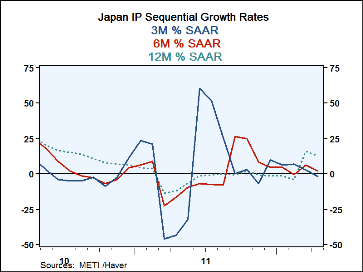 Global| Jun 14 2012
Global| Jun 14 2012Japan's IP Disappoints
Summary
Japan's IP fell by 0.2% in April after surging by 1.3% in March. The industrial production growth rates have been progressively diminishing over more recent periods. Only transportation after slowing from an unsustainably strong pace [...]
 Japan's IP fell by 0.2% in April after surging by 1.3% in March. The industrial production growth rates have been
progressively diminishing over more recent periods. Only transportation after slowing from an unsustainably strong
pace has bounced back from Japan's disaster of last year and continued to run at a still super-heated
pace around the 30% mark.
Japan's IP fell by 0.2% in April after surging by 1.3% in March. The industrial production growth rates have been
progressively diminishing over more recent periods. Only transportation after slowing from an unsustainably strong
pace has bounced back from Japan's disaster of last year and continued to run at a still super-heated
pace around the 30% mark.
Among product groups only intermediate goods output is still humming along as Consumer goods and investment goods output trends are on declining paths and are falling over three months. Mining and electric and gas output are both down over three months. Japan has shuttered its nuclear reactors in the aftermath of its nuclear accident and increased fuel imports to replace the lost power production.
Manufacturing sector industries are back to 86% of their pre-crisis peak. While transportation output is back to 92% of its past peak and has made the most complete sector recovery.
In the new quarter (one month into Q2 with April data) the level of output over the Q1 average is showing a 0.6% annual rate of expansion as the surge in output at quarter-end still dominates the small 0.2% drop in April. Auto output recently has notched up further and is rising at a 62% annual rate early in Q2 over the level in Q1.
In the US we find that automakers are still elevating their inventories which are near the lower 25th percentile of their five year range. There seems to be still a good demand in the US at least to rebuild depleted stocks of autos. But beyond that, Japan does not have a lot of bright spots in manufacturing as the strong yen lingers and overseas growth continues to fade.
Robert Brusca
AuthorMore in Author Profile »Robert A. Brusca is Chief Economist of Fact and Opinion Economics, a consulting firm he founded in Manhattan. He has been an economist on Wall Street for over 25 years. He has visited central banking and large institutional clients in over 30 countries in his career as an economist. Mr. Brusca was a Divisional Research Chief at the Federal Reserve Bank of NY (Chief of the International Financial markets Division), a Fed Watcher at Irving Trust and Chief Economist at Nikko Securities International. He is widely quoted and appears in various media. Mr. Brusca holds an MA and Ph.D. in economics from Michigan State University and a BA in Economics from the University of Michigan. His research pursues his strong interests in non aligned policy economics as well as international economics. FAO Economics’ research targets investors to assist them in making better investment decisions in stocks, bonds and in a variety of international assets. The company does not manage money and has no conflicts in giving economic advice.






